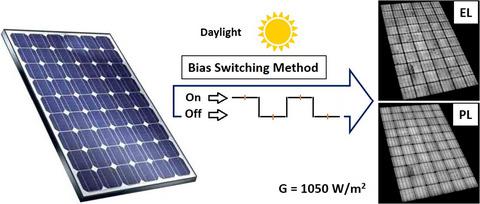当前位置:
X-MOL 学术
›
Energy Sci. Eng.
›
论文详情
Our official English website, www.x-mol.net, welcomes your
feedback! (Note: you will need to create a separate account there.)
Daylight luminescence system for silicon solar panels based on a bias switching method
Energy Science & Engineering ( IF 3.5 ) Pub Date : 2020-07-13 , DOI: 10.1002/ese3.781 Miguel Guada 1 , Ángel Moretón 1 , Sofía Rodríguez‐Conde 1, 2 , Luis Alberto Sánchez 1 , Mario Martínez 2 , Miguel Ángel González 1 , Juan Jiménez 1 , Leonardo Pérez 2 , Vicente Parra 2 , Oscar Martínez 1
Energy Science & Engineering ( IF 3.5 ) Pub Date : 2020-07-13 , DOI: 10.1002/ese3.781 Miguel Guada 1 , Ángel Moretón 1 , Sofía Rodríguez‐Conde 1, 2 , Luis Alberto Sánchez 1 , Mario Martínez 2 , Miguel Ángel González 1 , Juan Jiménez 1 , Leonardo Pérez 2 , Vicente Parra 2 , Oscar Martínez 1
Affiliation

|
Among the many characterization techniques for solar panel testing, two, electroluminescence (EL) and photoluminescence (PL), can provide useful visual information about the presence of different types of cell defects. EL is performed outdoors by night in commercial solar plants due to the very weak luminescence emission compared to sunlight. PL faces the added difficulty of needing to find a large‐area homogeneous light source to excite the modules. Since nighttime work poses many drawbacks and risks, a daylight outdoor EL/PL system would be useful for offering safe inspection of solar plants. We present daylight luminescence techniques based on a bias switching method, in which a pulsed luminescence signal is obtained by alternating the polarization state of the solar panels, synchronizing it with the luminescence image detection by an InGaAs camera. Fast switching and selecting an optimized exposure time are key to achieving high‐quality images. The daylight luminescence method described herein allows both EL and PL luminescence images to be obtained, even under high solar irradiance conditions.
中文翻译:

基于偏置切换方法的硅太阳能电池板日光系统
在用于太阳能电池板测试的众多表征技术中,电致发光(EL)和光致发光(PL)这两种技术可以提供有关不同类型的电池缺陷存在的有用的可视信息。由于与日光相比非常弱的发光发射,因此在商用太阳能发电厂的户外夜间进行电致发光。PL面临着额外的困难,即需要找到一个大面积的均匀光源来激发模块。由于夜间工作带来许多弊端和风险,因此日光户外EL / PL系统可用于提供对太阳能发电厂的安全检查。我们提出一种基于偏压切换方法的日光发光技术,其中通过改变太阳能电池板的极化状态来获得脉冲发光信号,将其与InGaAs摄像机的发光图像检测同步。快速切换和选择最佳的曝光时间是获得高质量图像的关键。本文所述的日光发光方法即使在高太阳辐射条件下也能够获得EL和PL发光图像。
更新日期:2020-07-13
中文翻译:

基于偏置切换方法的硅太阳能电池板日光系统
在用于太阳能电池板测试的众多表征技术中,电致发光(EL)和光致发光(PL)这两种技术可以提供有关不同类型的电池缺陷存在的有用的可视信息。由于与日光相比非常弱的发光发射,因此在商用太阳能发电厂的户外夜间进行电致发光。PL面临着额外的困难,即需要找到一个大面积的均匀光源来激发模块。由于夜间工作带来许多弊端和风险,因此日光户外EL / PL系统可用于提供对太阳能发电厂的安全检查。我们提出一种基于偏压切换方法的日光发光技术,其中通过改变太阳能电池板的极化状态来获得脉冲发光信号,将其与InGaAs摄像机的发光图像检测同步。快速切换和选择最佳的曝光时间是获得高质量图像的关键。本文所述的日光发光方法即使在高太阳辐射条件下也能够获得EL和PL发光图像。











































 京公网安备 11010802027423号
京公网安备 11010802027423号